

The MacBook Pro is a lie - The Verge. Microsoft bascule PowerShell en open source, des versions Linux et macOS disponibles. Microsoft vient de passer son PowerShell en open source, annonçant dans la foulée une arrivée prochaine sur Linux et macOS.
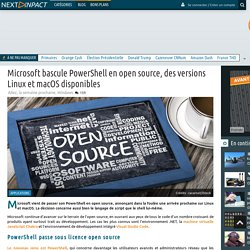
La décision concerne aussi bien le langage de script que le shell lui-même. Microsoft continue d’avancer sur le terrain de l’open source, en ouvrant aux yeux de tous le code d’un nombre croissant de produits ayant surtout trait au développement. Les cas les plus connus sont l’environnement .NET, la machine virtuelle JavaScript Chakra et l’environnement de développement intégré Visual Studio Code. PowerShell passe sous licence open source Le nouveau venu est PowerShell, qui concerne davantage les utilisateurs avancés et administrateurs réseau que les développeurs. PowerShell est bâti sur l’environnement .NET. Des préversions pour Linux et macOS. Windows 10 Upgrade: First 5 things to do after Windows 10 download. Windows users, it’s time to breathe a collective sigh of relief.
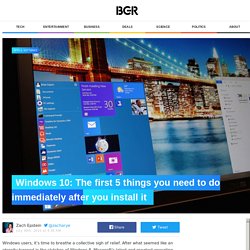
After what seemed like an eternity trapped in the clutches of Windows 8, Microsoft’s latest and greatest operating system is finally here to save us. SCCM 2012 - Allow End User to Run Application As Administrator - The Sysadmins. I’ve been spending a bit of time recently, working around various constraints of working in an environment where UAC is enabled and end users have no local administrative rights over their machines.
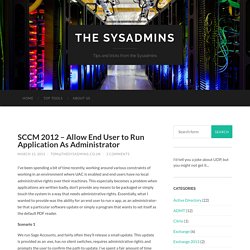
This especially becomes a problem when applications are written badly, don’t provide any means to be packaged or simply touch the system in a way that needs administrative rights. Essentially, what I wanted to provide was the ability for an end user to run x app, as an administrator- be that a particular software update or simply a program that wants to set itself as the default PDF reader. Scenario 1 We run Sage Accounts, and fairly often they’ll release a small update.
This update is provided as an .exe, has no silent switches, requires administrative rights and prompts the user to confirm the path to update. Scenario 2 PDF readers. SCCM 2012 - L'administration centrée sur l'utilisateur : Introduction - MEN IN CLOUD. Vi. Pour les articles homonymes, voir VI. vi est un éditeur de texte en mode texte plein écran écrit par Bill Joy en 1976 sur une des premières versions de la distribution Unix BSD.
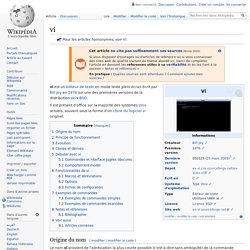
Il est présent d'office sur la majorité des systèmes Unix actuels, souvent sous la forme d'un clone du logiciel vi originel. Linux Commands With Appendicies. Container-Based Controls versus Dynamic Authorization: The Difference in Windows Environments (Part 1 of 2) By Sandeep Chopra. If you are debating whether to upgrade to Windows Server 2012, plenty of articles describe its new security benefits (for example, see here and here). Fewer articles discuss the basic shift in Access Management this release can enable.
To understand the potential benefits of one key feature, Dynamic Access Control, it’s useful to compare this approach with more well-known models of Access Management, such as ACLs and Security Groups. This blog is first in a series that compares how Access Management was handled in Windows environments prior to the 2012 release with what’s possible now. Container-Based Controls: ACLs and Group Management ACLs and Security Groups are currently the most ubiquitous model of Access Management. The ACL and Security Group model is both manual (with permissions defined per container, by an Administrator), and static (pre-determined and applied ahead of time). ForensicsWiki. DeployHappiness. Hey, Scripting Guy! Blog – Learn about Windows PowerShell.
How to Prevent Users from Changing Permissions on File Servers. On file servers in corporate environments one typically does not want users to change permissions, even on their own files.
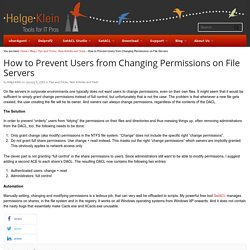
It might seem that it would be sufficient to simply grant change permissions instead of full control, but unfortunately that is not the case. The problem is that whenever a new file gets created, the user creating the file will be its owner. And owners can always change permissions, regardless of the contents of the DACL. The Solution In order to prevent “orderly” users from “tidying” the permissions on their files and directories and thus messing things up, often removing administrators from the DACL, too, the following needs to be done: Only grant change (aka modify) permissions in the NTFS file system.
The clever part is not granting “full control” in the share permissions to users. Naming Files, Paths, and Namespaces (Windows) All file systems supported by Windows use the concept of files and directories to access data stored on a disk or device.
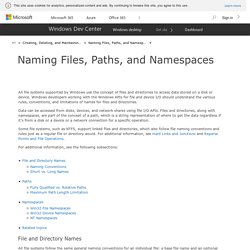
Windows developers working with the Windows APIs for file and device I/O should understand the various rules, conventions, and limitations of names for files and directories. Data can be accessed from disks, devices, and network shares using file I/O APIs. Files and directories, along with namespaces, are part of the concept of a path, which is a string representation of where to get the data regardless if it's from a disk or a device or a network connection for a specific operation. For additional information, see the following subsections: File and Directory Names.